ICTC Overviews summarize findings from full-length studies. To read the original report, visit it here.
Study Scope
This report explores how Canada can play a pivotal role in global food supplies by leveraging digital technologies to navigate intense competitive pressures, labour shortages, food security and safety, and food traceability.
This study highlights agri-food trends, tech investments, tech adoption opportunities and challenges, labour market demand and key skills and roles.
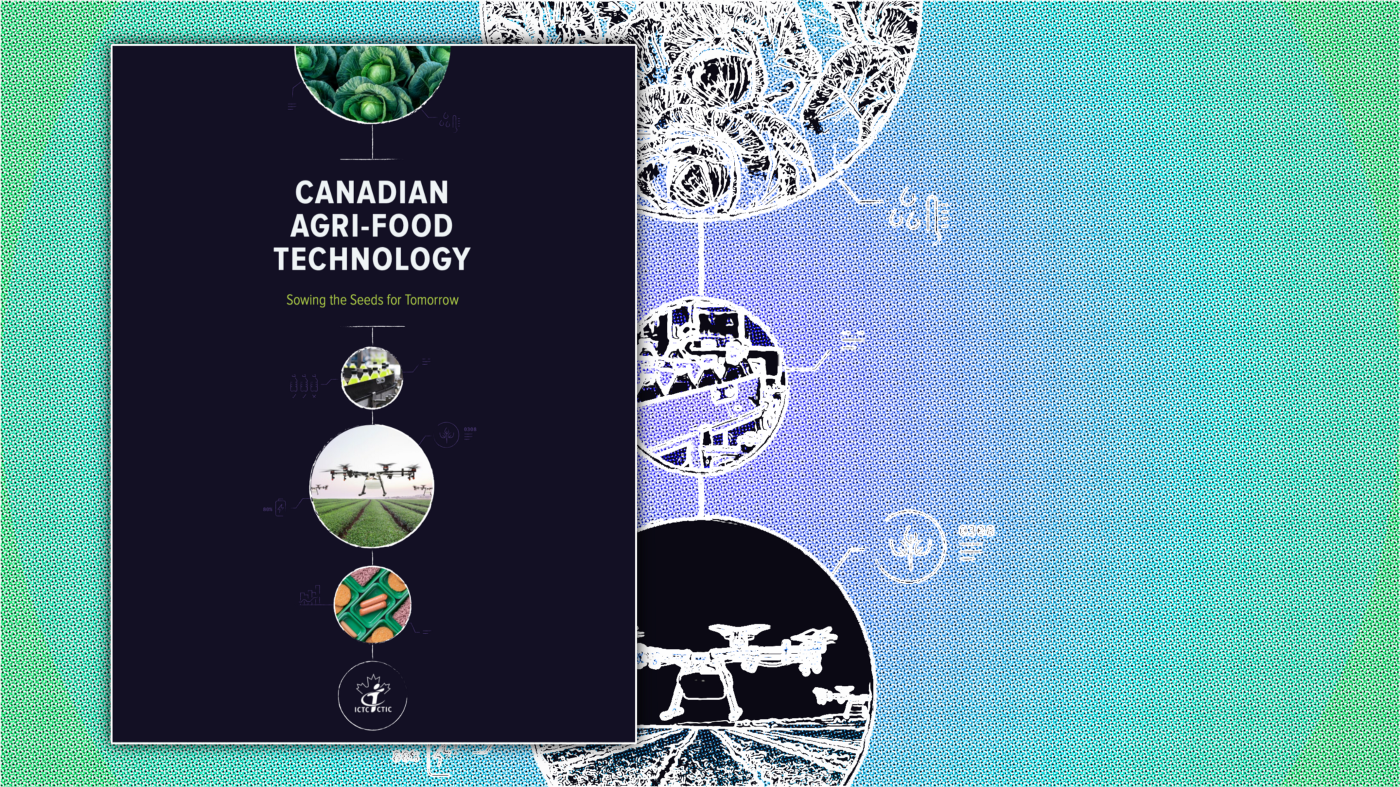
Study Context
As the world’s population grows, the global food and agriculture sector will need to produce more while reducing its environmental footprint.
ICTC estimates that demand in the agri-food technology industry will reach approximately 49,000 additional workers by Q4 of 2025. If filled, this will bring total employment in the industry to 683,000 workers by the end of 2025.
As Canada’s agri-food system turns to high tech, traditional tech occupations will be most in demand, including firmware and hardware developers, software developers, data scientists, business analysts, and machine learning experts, among others.
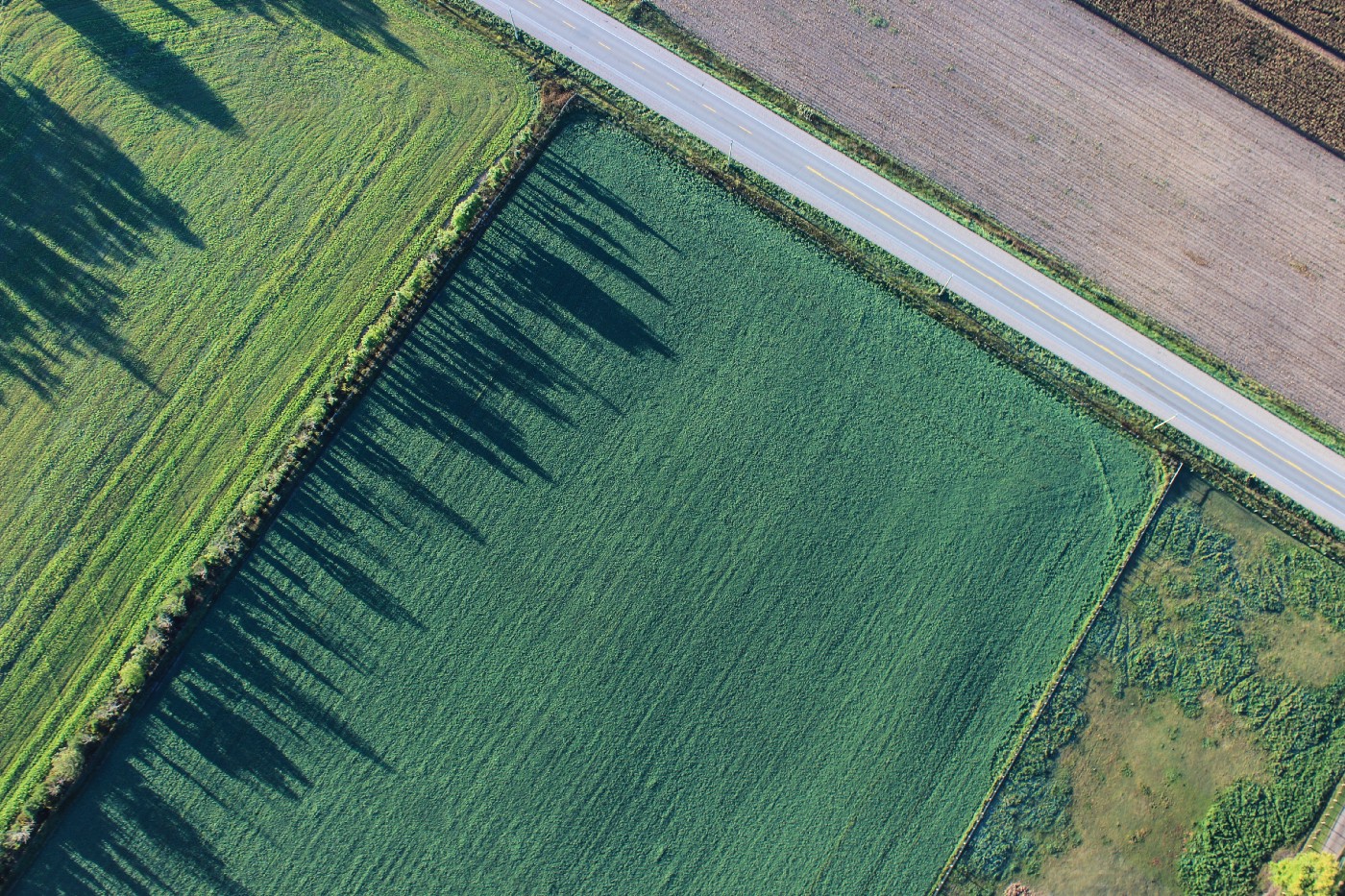
Photo by Sveta Fedarava on Unsplash
Study Findings
Canada’s agri-food sector spans many industries, including primary agriculture, aquaculture, and food and beverage processing, retailers and wholesalers, and service providers.
Sector Size
- In 2018, agri-food stakeholders generated $143.1 billion of gross domestic product (GDP) in 2018, accounting for 7.4% of total Canadian GDP
- The sector also employed approximately 2.3 million people in 2018, equal to 12.5% of Canadian employment (1 in 8 Canadian jobs)

Defining Agri-Food Technology: Any advanced technology used by the agri-food sector in food production, for instance, to make food production safer, more efficient or environmentally friendly, or to create novel types of food.

Agri-Food Tech Investments
In 2019, Canada was seventh globally in agri-food total dollar value of new investment deals and sixth in the actual number of new deals.
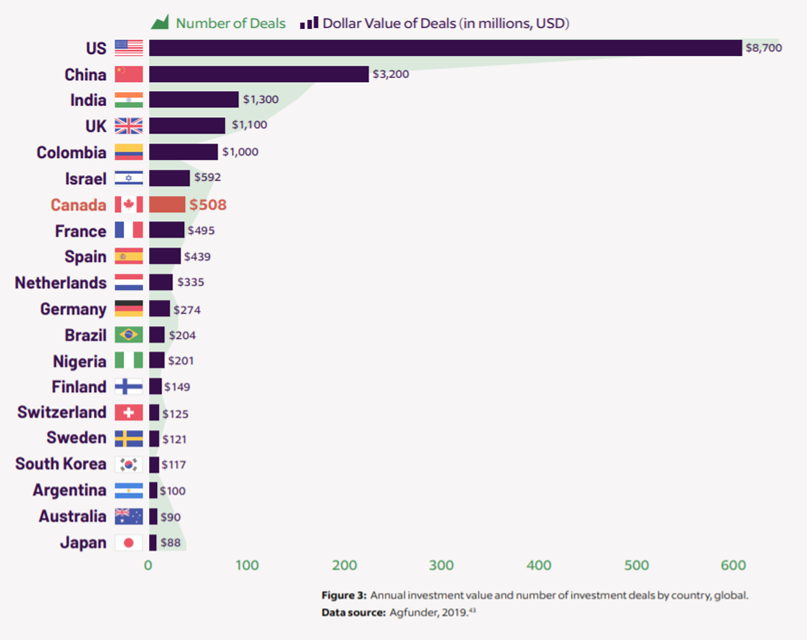
Agri-food Technology Trends
Most often cited agri-food trends include precision agriculture, controlled environment agriculture, sustainable food production, and agricultural biotechnology.
Precision agriculture: a farm management strategy that seeks to “take the intuition and guesswork out of farming by allowing producers to harness the power of big data.”
- Involves a suite of technologies (GPS, sensors, big data, AI) that collect and share information about the local soil, climate, plants, and livestock and then use that data to inform agriculture processes and decision-making
Controlled environment agriculture (CEA): the production of plants and their products inside controlled environment structures such as greenhouses, vertical farms, and growth chambers.
- Enables farmers to grow fruits and vegetables in ideal settings at maximum efficiency and productivity, shelter from unfavourable climate and weather patterns, and grow certain types of food in inhospitable places
Sustainable food production: Food and agriculture are instrumental in climate change, conservation, biodiversity efforts. The sector’s impact on the environment accounts for
- approximately 21% to 37% of global GHGs
- 70% of freshwater use, and
- more than 50% of the world’s habitable land
In 2021, the federal government committed to achieving net-zero emissions by 2050.
Agricultural Biotechnology and the Bioeconomy
Canada’s bioeconomy uses resources from agriculture, forestry, fishery-based biomass, and other organic waste to create bio-based products (renewable alternatives to non-renewable industrial products).
Agricultural biotechnology is a set of sophisticated techniques and tools used by scientists to understand or manipulate the genetic makeup of organisms for the production or processing of agricultural goods.
Various branches of biotechnology (some of which are relevant to agriculture) include:
- Green biotechnology: applied to agricultural processes, for example, the selection and domestication of plants via micropropagation, or the design of transgenic plants
- Yellow biotechnology: used in food production, for example in winemaking, cheesemaking, and brewing by fermentation as well as biotechnology-based approaches for the control of harmful insects, and the utilization of active ingredients or genes of insects, etc.
- Red biotechnology: used for medical purposes, including the engineering of genetic cures. In the agri-food sector, red biotechnology focuses on improving livestock health
Prominent Tech Verticals and Business Lines
ICTC analyzed company descriptions to identify 10 product and service lines:
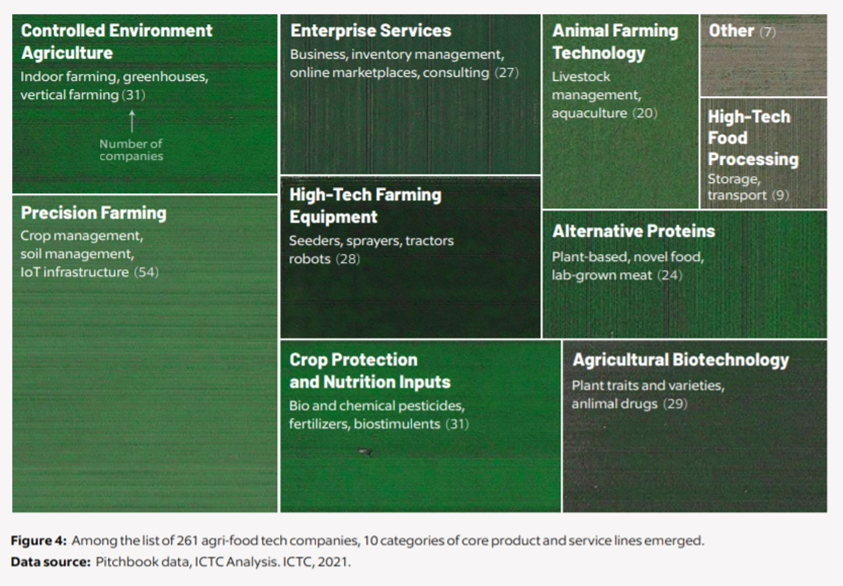
Location of Canadian Agri-Tech Company Headquarters
ICTC’s dataset of companies is primarily located in Canada (93%) and the U.S. (5%).
Among Canadian companies:
- 33% are in Ontario
- 18% in British Columbia
- 17% in Alberta
- 11% in Quebec
- 10% in Saskatchewan
- 5% in Manitoba
Typical Company Size
Some 96% of the companies in the agri-food technology dataset are SMEs:
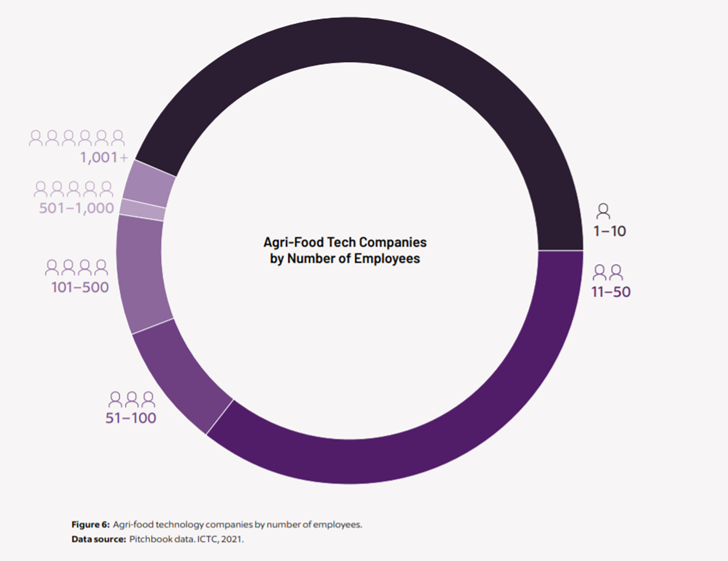
Labour Market Demand
A 2019 report by the Royal Bank of Canada found that Canada’s agri-food sector faces a severe skills and labour shortage, and noted the sector is moving into a “decade-long demographic crisis.”
A forecast from Canadian Agricultural HR Council (CAHRC) cautioned that the labour gap in the agricultural sector will almost double by 2029.
- Under a moderate growth scenario, ICTC Expects demand in the agri-food technology to reach approximately 49,000 workers by Q4 of 2025. If filled, this will bring total employment to 683,000 workers by the end of 2025.
Historical Employment Data
A fourth revolution in agricultural technology is underway — and it’s all about data. Tech roles are in growing demand:
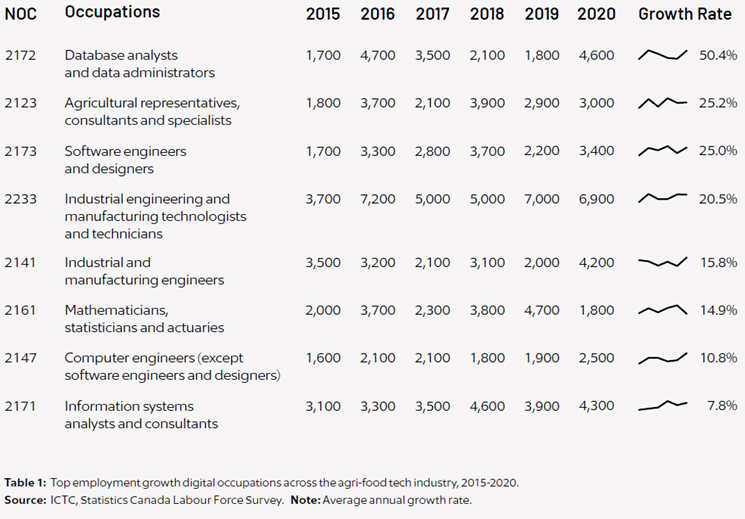
Job Postings Data
Advanced technology skills and education in three business-to-business domains:
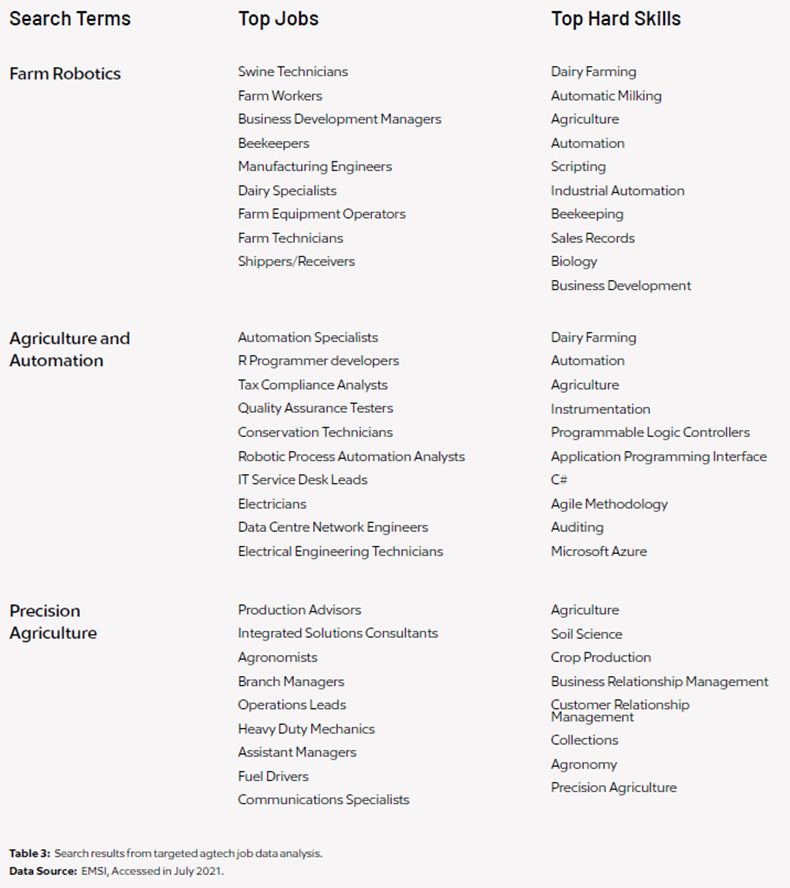
Technical Roles and Skill Sets
Traditional tech occupations were identified as agtech’s most in-demand technical roles: firmware and hardware developers, software developers, mobile app developers, web full stack developers, front-end developers, back-end developers, data scientists, business analysts, and UI/UX designers.
- Certain tech roles were identified as being particularly hard to find: blockchain engineers, machine learning experts, data scientists, and data infrastructure engineers
Interdisciplinary Talent
Interdisciplinary competencies and skills are required, including agriculture, horticulture, and biology, as well as engineering skills, manufacturing skills, digital skills, robotics, and data analytics.
- Some of these skills are acquired at school, while others are gained through work experience
- In recent years, advances in computer science have seen a growth in hybrid university programs, such as computational biology and bioinformatics
Agri-Food Tech Business Domains
The agri-food technology ecosystem spans so many business domains. The following is an example of the technical roles required in the alternative protein domain:

Technology Adoption
In the late 1980s and 90s, Canadian farms and agri-food manufacturing began switching from the second wave industrial revolution of electrical machines to “third wave” new robotics and automation technologies (including automated crop harvesting techniques, auto steer, sectional control, and GPS, which are now standard).
In the last 10 years, agricultural technology adoption has shifted to “fourth wave” cyber-physical systems with a focus on sustainability — Agriculture 4.0.
ICTC’s survey of primary producers and agricultural technology businesses across Canada finds that although older “third wave” technologies often see high rates of adoption, Canada’s adoption rates for emergent technologies are limited.
Barriers to Adoption
The top three barriers to adoption are cost of high initial investment, internet speeds and cellular data coverage, and lack of training or knowledgeable people.

Labour Shortages
Witnesses before the Parliamentary Agriculture and Agri-Food Committee highlighted Canada’s shortages in the talent required to design, build, and service high-tech equipment.
Moreover, the technology that producers adopt to address manual labour shortages, can in turn create new labour gaps, hampering technology adoption.
Interoperability
Challenges to tech adoption also include issues of interoperability: proprietary software constraints, difficult or nonexistent application programming interfaces, legislation over the right to repair personal equipment, and the general lack of integration between brands.
The growing popularity of open source software could alleviate interoperability challenges.
The Way Forward in Agri-Food Tech
Research shows that producer satisfaction with agricultural technology varies by technology type, but generally correlates with performance and clear ROI.
In the development of agri-food tech, it will be important to integrate more and earlier feedback from primary producers to ensure the usefulness and ease of use of new technology.
Adequately planning for in-demand roles and specialized skills are required for Canada’s agriculture sector to realize the competitive advantage that technology can impart on food security, the economy, and the mitigation of climate change.
ICTC Overviews summarize findings from full-length studies. To read the original report, visit it here.
